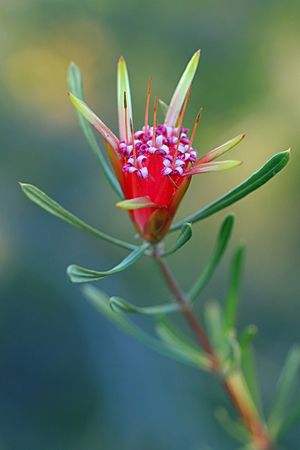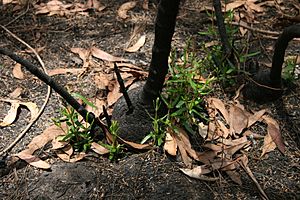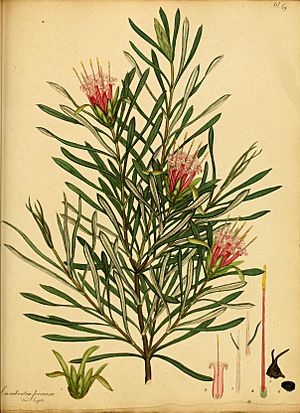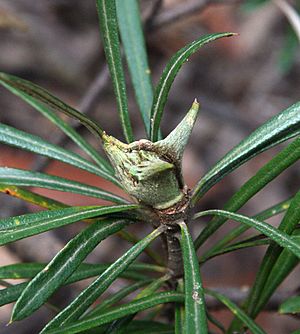Mountain devil facts for kids
Quick facts for kids Mountain devil |
|
|---|---|
 |
|
| Scientific classification | |
| Genus: |
Lambertia
|
| Species: |
formosa
|
 |
|
| Range of L. formosa | |
| Synonyms | |
|
|
The mountain devil (scientific name: Lambertia formosa) is a special type of shrub. It belongs to the Proteaceae plant family. This plant only grows in New South Wales, Australia. An English botanist named James Edward Smith first described it in 1798.
It usually grows in heathland or open forests. You can find it in soils that are sandy, often based on sandstone. The mountain devil grows as a shrub, usually about 2 meters (7 feet) tall. It has many stems coming from a woody base called a lignotuber. This special base helps it grow back after a bushfire.
The plant has stiff, narrow leaves. Its pink to red flowers usually appear in spring and summer. Each flower head is made of seven individual tube-shaped flowers. The plant gets its common name from its unique, horned, woody fruits. People used to make small devil-like figures from these fruits.
Mountain devil flowers produce a lot of sweet nectar. This nectar attracts honeyeater birds, which help pollinate the plant. Even though it's not grown very often, L. formosa is easy to grow. It needs soil that drains well and a spot with some sun. You can easily grow new plants from its seeds. Unlike other plants in its group, L. formosa is very strong against a soil disease called Phytophthora cinnamomi.
Contents
How the Mountain Devil Got Its Name
Scientists Joseph Banks and Daniel Solander first collected samples of Lambertia formosa. They found these plants in 1770 when Lieutenant James Cook landed at Botany Bay. These samples likely came from sandy areas near what is now La Perouse.
In 1798, English botanist James Edward Smith officially described the shrub. He also created a new group of plants called Lambertia. He named this group after another English botanist, Aylmer Bourke Lambert. The plant's specific name, formosa, is a Latin word meaning 'handsome'.
An English plant expert, Henry Cranke Andrews, wrote in 1799 that this plant was "unquestionably the most beautiful" of all the plants brought from Australia. However, Joseph Knight later said in 1809 that the name "handsome" really only fit the flowers, because the leaves often looked a bit sickly.
There are ten different species in the Lambertia group. Lambertia formosa is the only one found in eastern Australia. All the others grow only in southwest Western Australia. Besides "mountain devil," another common name for it is "honey flower." The "mountain devil" name comes from how its fruit looks like a devil's head.
What the Mountain Devil Looks Like
Lambertia formosa is a spreading shrub that can grow up to 2 meters (7 feet) tall. It has one or more stems that grow from a woody base called a lignotuber. New parts of the plant are covered with fine brownish hairs.
Its stiff leaves grow in groups of 3, or sometimes 4 to 6, around the stems. They are long and narrow, like a spear. The leaves can be from 1 to 8 centimeters (0.4–3 inches) long and 0.2–0.7 centimeters wide. They usually have a pointed tip.
You can see flowers on the plant at any time of year. However, they are most common during spring and summer, from September to January. The base of the flowers is covered by green and red leaf-like structures called bracts.
Almost all flower heads have seven small, individual flowers. These flowers, called florets, can be red or pink. The tube-shaped flowers are about 4.5 centimeters (1.6 inches) long. The styles, which are part of the flower's reproductive system, stick out another 1–1.5 centimeters (0.5 inches).
After flowering, woody fruits grow. These fruits are 2–3 centimeters long and 1–2 centimeters wide. They have two sharp, horn-like bumps that are 1–1.5 centimeters long. They also have a small "beak" about 0.5 centimeters long. The fruits start pale green and then turn grey-brown. Each woody fruit has two flat, winged seeds inside. These seeds stay in the fruit until a fire burns them.
Where the Mountain Devil Lives
The mountain devil only grows in New South Wales, Australia. You can find it on or east of the Great Dividing Range. Its range stretches from near Braidwood north to Port Stephens. It also grows in some parts of northern New South Wales, around Grafton and between Red Rock and Yamba.
In the Sydney Basin, it grows from sea level up to 1100 meters (3600 feet) high. It lives in areas that get between 800 and 1400 millimeters (32–55 inches) of rain each year.
Lambertia formosa grows in heathland, mallee shrubland, and dry sclerophyll forests. It prefers sandy or rocky soils. In heathlands, it often grows with plants like dwarf apple (Angophora hispida) and rusty banksia (Banksia oblongifolia). In woodlands, you might find it with trees like silvertop ash (Eucalyptus sieberi) and red bloodwood (Corymbia gummifera).
Life Cycle and Ecology

The mountain devil has amazing ways to survive bushfires. It can grow back from its woody lignotuber base. It is also a serotinous plant. This means it keeps its seeds in its canopy, and they are released only after a fire.
The number of flowers a plant produces is highest two or three years after a fire. Studies have shown that plants that experience fires too often (less than seven years apart) produce fewer fruits. Mountain devil plants can live for more than 60 years.
The red/pink color and tube shape of the flowers, along with their nectar, show that honeyeater birds pollinate them. These birds perch on the plant to drink the nectar. Some honeyeater species seen feeding on mountain devil flowers include the white-eared honeyeater and the New Holland honeyeater. More honeyeaters are found where there are more flowers.
Caterpillars of some Australian cup moth species, like Xylorycta strigata, eat the leaves. They also make burrows in the wood of the plant.
Growing Mountain Devil Plants

Lambertia formosa was one of the first Australian plants brought to England for cultivation. In 1788, seeds were sent from Botany Bay to a nursery in London. The first recorded flowering of a cultivated plant was in July 1798.
This plant is quite easy to grow if it has a sunny spot and soil that drains well. It can also handle different types of soil and some shade. Its flowers attract birds, which is great because they provide food for them all year. The plant also grows well if you prune it.
Seeds usually sprout within 25 to 60 days after you plant them. Young, firm shoots are best for making cuttings to grow new plants. You usually don't need to use fertilizers. However, if you do, use slow-release fertilizers that are low in phosphorus. The mountain devil can handle frost and grows well in mild to warm climates.
Scientists have found that Lambertia formosa is resistant to a plant disease called dieback (caused by Phytophthora cinnamomi). This is special because all other plants in the Lambertia group are very sensitive to this root rot disease. Because of this, the mountain devil could be used as a rootstock. This means other Lambertia species from Western Australia, which are sensitive to dieback, could be grafted onto its roots to help them survive.


